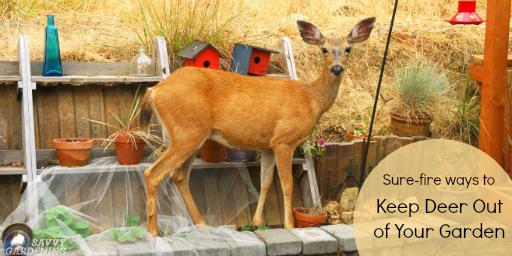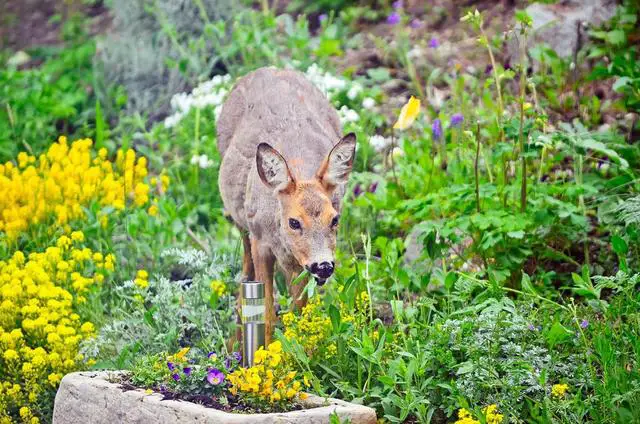“Beyond the confines of an 8-foot fence, discover ingenious solutions to protect your cherished plants from marauding deer. Explore effective alternatives and find out how to safeguard your garden with innovative strategies that deter these graceful yet voracious creatures. Unleash nature-friendly and practical methods, transforming your green space into an oasis free from unwanted nibbling.”
Effective Methods to Keep Deer Away from Your Plants Without Using an 8-Foot Fence

Dealing with deer in your garden can be a frustrating experience, but there are several effective methods to keep them away without having to install an 8-foot fence. One approach is to choose deer-resistant outdoor plants. While hungry deer may eat almost anything, they tend to avoid plants with prickly or fuzzy foliage. Additionally, heavily fragranced plants are also less appealing to them. By incorporating textured and aromatic plants as borders for your garden beds, you can help deter deer from feasting on your plants.
Another simple yet effective method is placing bar soap near your outdoor plants. The scent of the soap is said to interfere with the deer’s sensitive sense of smell, making them less likely to approach your garden. Choose a brand with a strong fragrance and hang bars from strings in trees or large shrubs. Alternatively, you can attach soap bars to stakes and place them around the edges of your garden beds.
Scattering human hair around your outdoor plants can also act as a natural deterrent for deer. The scent of human hair mimics the presence of humans in the area, which makes deer hesitant to enter the garden. You can obtain hair clippings from your barber or hairdresser and scatter them across your garden beds like mulch. Another option is stuffing the hair into pantyhose and hanging these “deer-deterrent stockings” out of sight throughout your landscape.
Applying a deer-repellant spray is another effective method for keeping deer away from your plants. Numerous commercially-made brands are available, most of which use foul scents and terrible tastes that deter deer. If you prefer a DIY approach, there are many recipes for homemade spray repellants using ingredients such as eggs, hot sauce, garlic, and clove oil.
Installing motion sensors near your outdoor plants can also help frighten deer away. Solar-powered motion sensor units are commonly used, but deer may quickly become accustomed to certain lights and repetitive sounds. Instead, consider using a motion-triggered device that squirts water or turns on a live radio broadcast. The sudden movement or unexpected noise can startle the deer and discourage them from approaching your garden.
Lastly, physically protecting your garden plants with barriers can be the most effective method of keeping deer at bay. Plastic netting or floating row covers are cost-effective options that provide a physical barrier between the deer and your plants. However, if you’re willing to invest in property fencing, make sure it is tall enough to prevent deer from jumping over it. Deer can jump up to 8 feet on level ground and even higher on sloped ground. A stockade fence is particularly effective as it prevents deer from seeing what’s on the other side, making them less likely to attempt jumping over it.
In conclusion, while dealing with deer in your garden can be challenging, there are several methods you can employ to keep them away without resorting to an 8-foot fence. By choosing deer-resistant plants, using bar soap, scattering human hair, applying repellent sprays, installing motion sensors, or implementing physical barriers like plastic netting or floating row covers, you can protect your outdoor plants from being feasted upon by these majestic but troublesome creatures.
Alternative Solutions for Protecting Your Plants from Deer Without a Tall Fence
1. Use Deer-Resistant Plants
Choosing plants that deer tend to avoid can be an effective way to protect your garden without the need for a tall fence. As mentioned earlier, deer are less likely to eat plants with prickly or fuzzy foliage, as well as those with strong fragrances. By incorporating these types of plants into your garden, you can create a natural deterrent for deer.
2. Install Motion-Activated Sprinklers
Motion-activated sprinklers can startle and deter deer from entering your garden. These devices use sensors to detect movement and then release a burst of water, scaring away the animals. This solution is particularly effective because it combines both a visual and auditory deterrent, making it more difficult for deer to become accustomed to the repellent.
3. Create Physical Barriers
While a tall fence may not be feasible for everyone, there are other physical barriers that can help protect your plants from deer. One option is to install individual wire cages around vulnerable plants. These cages should be at least 6 feet high and have small enough gaps in the wire mesh to prevent deer from reaching through. Another option is using fishing line or string at various heights around your garden to create an invisible barrier that deer will struggle to navigate.
4. Utilize Scent Repellents
Deer have a highly sensitive sense of smell, so utilizing scent repellents can help keep them away from your plants. There are commercially available sprays that emit odors that repel deer, such as predator urine or rotten egg scent. Additionally, you can make homemade repellents using ingredients like garlic, hot peppers, or vinegar mixed with water.
5. Plant Deterrents
Certain plants are known to repel deer due to their strong scent or taste. For example, planting marigolds, lavender, or daffodils around your garden can help deter deer from entering. These plants not only add beauty to your garden but also act as a natural deterrent.
By implementing these alternative solutions, you can protect your outdoor plants from deer without the need for a tall fence. Experiment with different methods and combinations to find what works best for your specific garden and local deer population. Remember that no solution is foolproof, but by using a combination of strategies, you can greatly reduce the damage caused by these majestic creatures.
Discover Non-Fence Options to Safeguard Your Garden from Hungry Deer

1. Plant Deer-Resistant Species
Consider choosing outdoor plants that are known to be deer-resistant. While hungry deer may eat almost anything, they tend to avoid plants with prickly or fuzzy foliage. They also dislike heavily fragranced plants. Experiment with different textured and aromatic plants, using them as borders for your garden beds. Keep in mind that deer herds may have different preferences, so what works in one area may not work in another.
2. Use Bar Soap as a Deterrent
Ordinary bar soap can be an effective way to keep deer away from your garden. The scent of the soap interferes with their sensitive sense of smell. Choose a brand with a strong fragrance and hang bars from strings in trees or large shrubs. Alternatively, attach soap bars to stakes and place them around the edges of your garden beds to deter deer.
3. Scatter Human Hair Around Your Plants
The scent of human hair can also deter deer from entering your garden. Ask your barber or hairdresser for some clippings, which are usually provided free of charge. Scatter the hair like mulch across your garden beds or stuff it into pantyhose and hang these “deer-deterrent stockings” out of sight throughout your landscape.
4. Apply Deer-Repellent Spray
Spray deterrents can help prevent deer from eating your plants if applied regularly. Many commercially-made brands are available, most of which use foul scents and terrible tastes to deter deer. Alternatively, you can try making homemade spray repellants using ingredients such as eggs, hot sauce, garlic, and clove oil.
5. Install Motion Sensor Devices
Some gardeners use solar-powered motion sensor units to scare away deer. However, deer herds may quickly learn that certain lights and repetitive sounds pose no real threat. Instead, consider installing a motion-triggered device that squirts water or turns on a live radio broadcast to startle the deer and keep them away.
6. Use Physical Barriers
A physical barrier is often the most effective method for protecting your garden from deer. Plastic netting or floating row covers can be used to cover your plants at a minimal cost. If you are willing to invest in property fencing, make sure it is tall enough as deer can jump up to 8 feet on level ground, and even higher on sloped ground. A stockade fence is recommended as deer are less likely to jump over when they cannot see what’s on the other side.
For expert gardening tips and advice, Utah gardeners can rely on the knowledgeable staff at Millcreek Gardens in Salt Lake City. Visit us today to learn more about growing and protecting your outdoor plants.
We Now Offer Curbside Pickup! Learn More Dismiss
Beyond Fencing: Innovative Ways to Prevent Deer Damage to Your Plants

Dealing with deer damage in your garden can be a frustrating experience. While fencing is often the go-to solution, there are also some innovative methods you can try to keep these majestic animals away from your plants.
1. Use Repellent Plants
In addition to choosing deer-resistant outdoor plants, you can also incorporate repellent plants into your garden. Certain plants, such as lavender, marigolds, and yarrow, have strong scents that repel deer. By strategically placing these plants around your garden beds or as borders, you can create a natural deterrent for deer.
2. Install Motion-Activated Sprinklers
Motion-activated sprinklers are an effective way to startle and deter deer from entering your garden. These devices use sensors to detect movement and then release a burst of water towards the intruder. The sudden spray of water surprises the deer and teaches them to avoid your garden area.
3. Create Noise and Disturbance
Deer are easily spooked by loud noises and unexpected disturbances. You can take advantage of this by using noise-making devices or wind chimes near your outdoor plants. You can also hang aluminum foil strips or CDs from trees or stakes to create visual disturbances that deter deer.
4. Utilize Predator Urine
The scent of predator urine, such as coyote or wolf urine, can signal danger to deer and keep them away from your garden. You can purchase predator urine products online or at gardening stores and apply them strategically around your outdoor plants.
5. Try Homemade Deer Repellents
If you prefer natural alternatives, you can make homemade deer repellents using ingredients commonly found in households. Recipes often include ingredients like garlic, cayenne pepper, vinegar, or rotten eggs. These concoctions can be sprayed onto your plants to create a taste and scent that deer find unappealing.
6. Install Reflective Devices
Deer are often scared away by bright lights and reflective surfaces. You can hang reflective tape or use aluminum foil strips near your garden to create flashes of light that deter deer. Additionally, placing mirrors strategically around your garden can confuse and scare off deer.
In conclusion, while fencing is an effective method for preventing deer damage to your plants, there are also innovative techniques you can try. By using repellent plants, motion-activated sprinklers, noise and disturbance devices, predator urine, homemade repellents, and reflective devices, you can protect your outdoor plants from the nuisance of deer. Experiment with different methods to find what works best for your specific garden and enjoy a beautiful landscape free from deer damage.
Practical and Efficient Strategies to Keep Deer from Eating Your Plants without a High Fence

1. Choose Deer-Resistant Outdoor Plants
One effective way to prevent deer from feasting on your garden is by selecting plants that are known to be deer-resistant. While hungry deer may eat almost anything, they tend to avoid plants with prickly or fuzzy foliage. Additionally, heavily fragranced plants are also less appealing to them. Experiment with different textured and aromatic plants, and consider using them as borders for your garden beds. Keep in mind that deer herds may have different preferences in different areas, so what works as a deterrent in one region might not be as effective in another.
2. Place Bar Soap Near Outdoor Plants
Using ordinary bar soap can help keep deer away from your garden. The scent of the soap is said to interfere with their sensitive sense of smell. Choose a brand with a strong fragrance and hang bars from strings in trees or large shrubs. Alternatively, you can attach soap bars to stakes and place them around the edges of your garden beds to deter the deer.
3. Scatter Human Hair Around Outdoor Plants
Another natural method to prevent deer from entering your garden is by scattering human hair around your outdoor plants. You can ask your barber or hairdresser for some clippings, which are usually provided free of charge. Scatter the hair like mulch across your garden beds or stuff it into pantyhose and hang these “deer-deterrent stockings” out of sight throughout the landscape.
4. Apply a Deer-Repellent Spray to the Outdoor Plants
Deer-repellent sprays can be an effective solution if applied regularly. Many commercially-made brands are available, which use foul scents and terrible tastes to deter deer from eating your plants. Alternatively, you can try making your own homemade spray repellents using ingredients like eggs, hot sauce, garlic, and clove oil. Experiment with different recipes to find what works best for your garden.
5. Add a Motion Sensor Near the Outdoor Plants
Some gardeners use solar-powered motion sensor units to scare away deer. However, deer herds may quickly become accustomed to certain lights and repetitive sounds if they pose no real threat. Instead, consider installing a motion-triggered device that squirts water or turns on a live radio broadcast. The sudden movement or unexpected noise will startle the deer and discourage them from approaching your plants.
6. Physically Protect Your Garden Plants Against Deer
The most effective method for keeping deer from eating your plants is by using physical barriers. Plastic netting or floating row covers can provide protection at a minimal cost. If you are willing to invest in property fencing, make sure it is tall enough as deer can jump up to 8 feet on level ground and even higher on sloped ground. A stockade fence is the best choice as deer are less likely to jump over when they cannot see what is on the other side.
By implementing these practical and efficient strategies, you can keep deer from feasting on your outdoor plants without the need for a high fence. Remember to experiment with different methods and adjust accordingly based on the behavior of local deer herds in your area.
Exploring Effective Alternatives to an 8-Foot Fence for Deterring Deer from Your Garden
1. Plant Deer-Resistant Species
One alternative to an 8-foot fence is to strategically choose deer-resistant plants for your garden. As mentioned earlier, deer tend to avoid prickly and fuzzy foliage, as well as heavily fragranced plants. By incorporating these types of plants into your landscape, you can create a natural deterrent that will discourage deer from feasting on your garden.
2. Use Repellent Sprays or Granules
Another effective alternative is to use repellent sprays or granules specifically designed to deter deer. These products typically contain foul-smelling compounds that irritate the deer’s sense of smell and taste, making them less likely to graze in your garden. Be sure to follow the instructions on the label and reapply the repellent regularly for maximum effectiveness.
3. Install Motion-Activated Devices
Motion-activated devices can be a useful tool in deterring deer from your garden without the need for a tall fence. These devices are triggered by movement and emit loud noises, flashing lights, or bursts of water that startle and scare off the deer. By placing these devices strategically around your garden, you can create a dynamic and unpredictable environment that makes it uncomfortable for deer to stay.
4. Create Physical Barriers
If you prefer a more physical solution, there are alternatives to an 8-foot fence that can still provide effective protection against deer. One option is installing shorter fences combined with additional deterrents such as netting or electric fencing. Netting can be draped over vulnerable plants or entire sections of your garden to physically block access for deer. Electric fencing can also be effective in keeping them out, but it requires careful installation and maintenance.
5. Utilize Scare Tactics
Scare tactics can be an inexpensive yet effective way to deter deer from your garden. Simple measures such as hanging wind chimes, aluminum foil strips, or reflective tape can create movement and noise that frighten deer away. Additionally, placing scarecrows or lifelike decoys in your garden can also provide a visual deterrent.
6. Create a Diverse Landscape
Deer are less likely to stay in an area where their preferred food sources are limited. By creating a diverse landscape with a variety of plants, you can reduce the attractiveness of your garden to deer. Incorporate plants that are known to be less appealing to deer alongside your more vulnerable plants to create a natural barrier.
In conclusion, while an 8-foot fence may be the most effective solution for deterring deer from your garden, there are alternative methods that can provide adequate protection without the need for such a tall structure. By incorporating deer-resistant plants, using repellents, installing motion-activated devices, creating physical barriers, utilizing scare tactics, and maintaining a diverse landscape, you can significantly reduce the likelihood of deer feasting on your outdoor plants.
In conclusion, while an 8-foot fence is an effective solution to deter deer from eating plants, there are alternative methods available. These include planting deer-resistant species, using repellents, employing scare tactics like motion-activated devices or reflective materials, and creating physical barriers with netting or cages. It’s important to assess the specific needs of your garden and experiment with different strategies to find the most suitable approach for deterring deer.















































